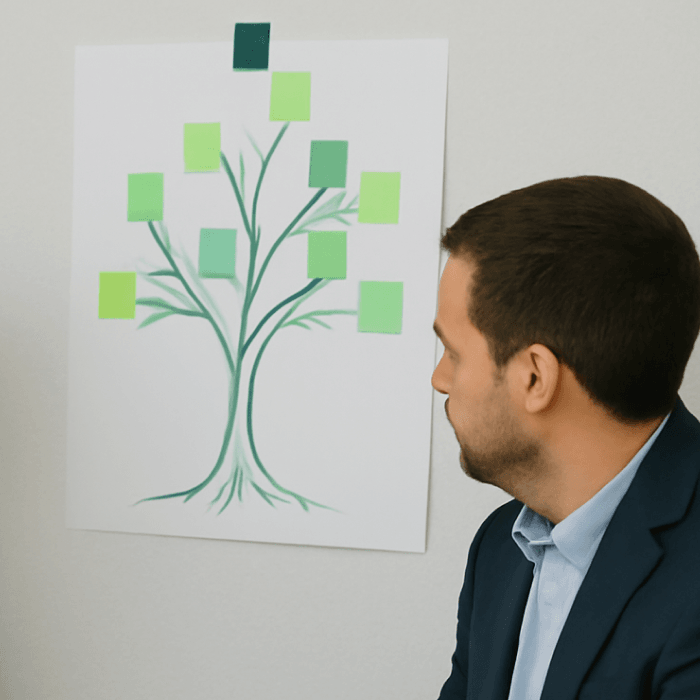Updated: January 3, 2025- 7 min read
When you’re a product manager, you might find yourself thrown into the deep end of product design without ever having had any experience in it. But never fear! You’re not trying to do the designers job for them, you’re bringing your awesome PM skills and user knowledge to the table, and collaborating on vital design tasks. Like user story mapping.
What Is User Story Mapping?
User story mapping is an exercise in which a development team aims to build the best user experience. It involves designing from the customer’s perspective, and it’s an effective and powerful way of building a user-centric design.
Instead of designing an interface/flow based on what you think looks good, user story mapping encourages teams to build something that helps get users to their goals as quickly and as natural-feeling as possible.
Pretty much every product has more than one type of user, and you somehow need to find the balance and build a product that serves all of them. If you’ve worked on user flows and user journeys, you’ve already understood the basic tenets. User story mapping is the act of turning that narrative into
User Story Mapping as an exercise is often credited to author and product design consultant, Jeff Patton. His book is pretty universally acknowledged in the product community as the go-to-guide on the subject.
Elements of a User Story Map
User Personas
Before you can build for your customers, you need to know who they are. User personas help to put a name to a concept, and make your customers seem more real. They may include:
Name
Age/generation
Location
Likes and dislikes
Hobbies
Aspirations
Pain points
Experience
Education
Favorite brands
Leaders they follow
Looking for a good user persona template? Look no further!
User Stories
User stories frame requirements from the perspective of the user, and allow developers to come up with creative solutions to their needs, rather than simply executing someone else’s ideas. Using formats like the one above, they briefly encapsulate user persona, the job they need the feature to accomplish, and what their overall needs are.
These stories are the main building blocks of your map, encompassing the person you’re building for, what they need, and why.
Backbone
The basis of your map, which may depend on how your organization has specifically arranged development. Usually, within agile development, you’ll be using epics and themes. The backbone of your user story map will help you to place your stories within the context of the wider business goals.
Nice-to-haves
Every user story map should have a ‘nice-to-have’ pile, or things that would be great to work on in the future once the main priorities have been shipped.
Benefits of User Story Maps
Deciding on the right frameworks and techniques to use can be a chore, especially when there are so many out there. So it’s important to know the benefits before committing.
Building consensus between teams
User story maps are a great way to communicate between teams because they’re written from a perspective that everyone can understand – the user’s. They’re free of technical jargon, whilst being open-ended enough to allow for creative collaboration. Everyone from developers to product managers and designers can understand the plan and get on board.
Staying user-focused
When you work from the perspective of your customer, you’re building for them rather than for your board of directors. This helps you to build a better product that does well in the market. Win win!
Communicating priorities
“Thanks, but maybe in V2” might be enough to placate some stakeholders…others not so much. Being able to put them to paper and add them to your ‘nice to haves’ on a user story map is a powerful tool when it comes to influencing without authority.
Who Can Do User Story Mapping?
Like many things in product development, a user journey map can be (and should be) a collaborative document. Everyone has a stake in how the product is built, and there are many perspectives that can help you to build a better product.
User story maps depict the entire product, and so it only makes sense that every discipline has a say in it. Everyone from design and engineering to marketing, finance, and sales should be able to collaborate on it.
…why Product Managers?
Now the juicy part. What do product managers bring to the table when it comes to user story mapping?
A user story map is, in essence, a visualisation of how the product is going to be built, from the perspective of the user.
It’s the product manager’s job to make sure that the product is built in the right way at the right time. It’s also their responsibility to be the voice of the user. These two key aspects of the role make PMs the perfect people to work on user story maps.
The way to be a great product manager that teams love collaborating with, is to listen to all of their inputs. Asking the right questions, and bringing the right data to back up your opinions will be your greatest contributions to A* cross-functional collaboration.
How to Do User Story Mapping
Set the story of your product
Before you can begin building your map, you need to define the destination, and have everyone on board with it. Everyone needs to fully understand what you’re building, who for, and why.
If your organization has more than just the product you’re working on, it’s also important to define how your product fits in with the overarching business goals.
Identify the goals
Break down exactly what it is your user will try to do with your product. For example, if you’re Spotify a goal might be to create a playlist, or upgrade to a premium account. Few products do one thing, so it’s important to break it down into the different goals a user could have when they boot it up.
Start with the most likely or most common goals and work backwards. Most products will have a knock-on effect, where you can’t achieve goal C without first having achieved A and B. For now, you want to just focus on the high-level actions that users will take within your product.
Match steps to goals
Once you’ve identified the goals, you need to figure out what the steps will be towards achieving those goals. The goals represent the very general What do people need to tap, type, click, or swipe in order to get closer to their goal? This is where you can add those details to each goal.
For example, on Spotify when you want to create a playlist, you have to…
Open app
Go to ‘Your Library’
Hit ‘Create Playlist’
Name playlist
Tap ‘Create’
At this stage in the user journey, your UI designers and developers will be your most valuable contributors. But it might also be worth asking marketing and sales to get involved later down the line. Things like chatbots and NPS survey pop-ups can eventually be integrated into the interface.
Prioritize and organize
It’s hardly ever possible for every single story to be addressed in your first MVP. In the final stage of user story mapping you’ll be arranging your stories, according to their priority, into different iterations. Usually the most common actions will be the main priorities, but you’ll be getting plenty of input from all kinds of different stakeholders, so using a more sophisticated prioritization technique may be necessary.
Updated: January 3, 2025





